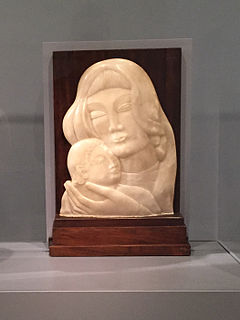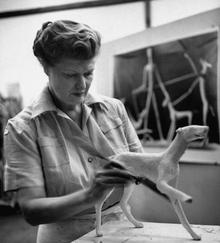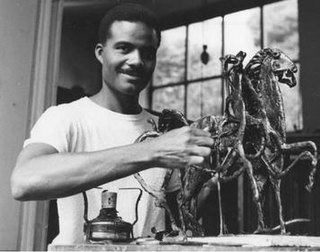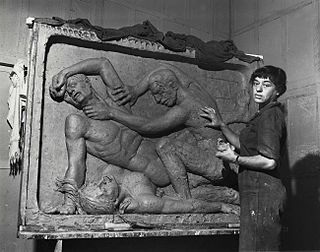Early life
Robus was born in 1885 in Cleveland, Ohio. [1] He attended the Cleveland School of Art in his hometown, the National Academy of Design in New York City, and the Académie de la Grande Chaumière in Paris. [1] [2]

Hugo Robus | |
|---|---|
| Born | 1885 Cleveland, Ohio, U.S. |
| Died | January 14, 1964 Ramapo, New York, U.S. |
| Education | Cleveland School of Art National Academy of Design Académie de la Grande Chaumière |
| Occupation | Sculptor |
Hugo Robus (1885 - January 14, 1964) was an American sculptor. He co-founded an art colony in New City, New York. His sculptures are in the permanent collections of the Whitney Museum of American Art, the Museum of Modern Art, the Metropolitan Museum of Art, and the Smithsonian American Art Museum.
Robus was born in 1885 in Cleveland, Ohio. [1] He attended the Cleveland School of Art in his hometown, the National Academy of Design in New York City, and the Académie de la Grande Chaumière in Paris. [1] [2]

Robus was a painter until the 1920s, when he became a sculptor. [2] He established an art colony in New City, New York with Henry Varnum Poor and Martha Kantor in 1918. [3]
His sculptures were exhibited at the Grand Central Art Galleries in New York City and Corcoran Gallery of Art in Washington, D.C. [2] They later became part of the permanent collections of the Whitney Museum of American Art, [2] the Museum of Modern Art and the Metropolitan Museum of Art in New York City, [3] [4] [5] as well as the Smithsonian American Art Museum in Washington, D.C. [1]
Robus resided at 567 South Mountain Road in New City, New York. [3] He had a son, Hugo Robus Jr. [2]
Robus died in 1964 at the Ramapo General Hospital in Ramapo, New York, at age 78. [2] [3]

Paul Howard Manship was an American sculptor. He consistently created mythological pieces in a classical style, and was a major force in the Art Deco movement. He is well known for his large public commissions, including the iconic Prometheus in Rockefeller Center and the Celestial Sphere Woodrow Wilson Memorial in Geneva, Switzerland. He is also credited for designing the modern rendition of New York City's official seal

Alexander Porfyrovych Archipenko was a Ukrainian and American avant-garde artist, sculptor, and graphic artist. He was one of the first to apply the principles of Cubism to architecture, analyzing human figure into geometrical forms.

Robert Laurent was a French-American modernist figurative sculptor, printmaker and teacher. His work, the New York Times wrote,"figured in the development of an American sculptural art that balanced nature and abstraction." Widely exhibited, he took part in the Whitney's 1946 exhibition Pioneers of Modern Art. Credited as the first American sculptor to adopt a "direct carving" sculpting style that was bolder and more abstract than the then traditional fine arts practice, which relied on models, Laurent's approach was inspired by the African carving and European avant-garde art he admired, while also echoing folk styles found both in the U.S. and among medieval stone cutters of his native Brittany. Best known for his virtuoso mastery of the figure, Laurent sculpted in multiple media, including wood, alabaster, bronze, marble and aluminum. His expertise earned him major commissions for public sculpture, most famously for the Goose Girl for New York City's Radio City Music Hall, as well as for Spanning the Continent for Philadelphia's Fairmount Park. After the Depression, he was also the recipient of several Works Progress Administration (WPA) Federal Art Project commissions under the New Deal, including a bas-relief called Shipping for the exterior of Washington, D.C.'s Federal Trade Commission Building, commissioned by the Treasury Department’s Section of Fine Arts in 1938.

Robert Indiana was an American artist associated with the pop art movement. His "LOVE" print, first created for the Museum of Modern Art's Christmas card in 1965, was the basis for his 1970 Love sculpture and the widely distributed 1973 United States Postal Service "LOVE" stamp. He created works in media including paper and Cor-ten steel.

William Zorach was an American sculptor, painter, printmaker, and writer. He won the Logan Medal of the arts. He is notable for being at the forefront of American Artists embracing cubism, as well as for his sculpture.
Rachel Harrison is an American visual artist known for her sculpture, photography, and drawing. Her work often combines handmade forms with found objects or photographs, bringing art history, politics, and pop culture into dialogue with one another. She has been included in numerous exhibitions in Europe and the US, including the Venice Biennale, the Whitney Biennial and the Tate Triennial (2009). Her work is in the collections of major museums such as The Museum of Modern Art, New York; Metropolitan Museum of Art, New York; Hirshhorn Museum and Sculpture Garden, Washington, D.C.; and Tate Modern, London; among others. She lives and works in New York.

Robert Engman was an American sculptor with works in the permanent collection of the Hirshhorn Museum, MOMA, the Whitney Museum of American Art, numerous college museums, and private collections.

Herbert Ferber was an American Abstract Expressionist, sculptor and painter, and a "driving force of the New York School."

Mary Callery was an American artist known for her Modern and Abstract Expressionist sculpture. She was part of the New York School art movement of the 1940s, 1950s and 1960s.

José Mariano de Creeft was a Spanish-born American artist, sculptor, and teacher known for modern sculpture in stone, metal, and wood, particularly figural works of women. His 16 ft bronze Alice in Wonderland sculpture climbing sculpture in Central Park is well known to both adults and children in New York City. He was an early adopter, and prominent exponent of the direct carving approach to sculpture. He also developed the technique of lead chasing, and was among the first to create modern sculpture from found objects. He taught at Black Mountain College, the Art Students League of New York, and the New School for Social Research. His works are in the Whitney Museum, the Metropolitan Museum of Art, the Museum of Modern Art, the Smithsonian American Art Museum, and many other public and private collections.
Arnold Blanch, was born and raised in Mantorville, Minnesota. He was an American modernist painter, etcher, illustrator, lithographer, muralist, printmaker and art teacher.

John W. Rhoden was an American sculptor from Birmingham, Alabama. Rhoden moved to New York in 1938, where he began studying with Richmond Barthé. Rhoden worked in wood and bronze, and created a number of commissioned works including Untitled (Family) at Harlem Hospital Center; Mitochondria at Bellevue Hospital Center in Manhattan; Curved Wal at the African American Museum in Philadelphia; Zodiacal Structure at the Sheraton Hotel in Philadelphia; and a sculpture of Frederick Douglass at Lincoln University.
George Earl Ortman was an American painter, printmaker, constructionist and sculptor. His work has been referred to as Neo-Dada, pop art, minimalism and hard-edge painting. His constructions, built with a variety of materials and objects, deal with the exploration off visual language derived from geometry—geometry as symbol and sign.

Ezio Martinelli was an American artist who belonged to the New York School Abstract Expressionist artists, a leading art movement of the post-World War II era.
Peter Grippe was an American sculptor, printmaker, and painter. As a sculptor, he worked in bronze, terracotta, wire, plaster, and found objects. His "Monument to Hiroshima" series (1963) used found objects cast in bronze sculptures to evoke the chaotic humanity of the Japanese city after its incineration by atomic bomb. Other Grippe Surrealist sculptural works address less warlike themes, including that of city life. However, his expertise extended beyond sculpture to ink drawings, watercolor painting, and printmaking (intaglio). He joined and later directed Atelier 17, the intaglio studio founded in London and moved to New York at the beginning of World War II by its founder, Stanley William Hayter. Today, Grippe's 21 Etchings and Poems, a part of the permanent collection at the Davis Museum and Cultural Center at Wellesley College in Wellesley, Massachusetts, is available as part of the museum's virtual collection.
The year 2013 in art involves some significant events.

Emil Fuchs, MVO, was an Austrian and American sculptor, medallist, painter, and author who worked in Vienna, London and New York. He painted portraits of Queen Victoria and Edward VII and was fashionable among London high society in the early 20th century.

Leo Amino was a Japanese-American sculptor known for his Abstract Expressionist sculptures created with a variety of materials, including wood, wire, and plastics.

Hélène Sardeau was an American sculptor, born in Antwerp, Belgium, who moved with her family to the United States when she was about 14 years old.
Martha Kantor (1896–1981) was an American glass painter. She was a member of the art colony in New City, New York, and "recognized as a master" of painting on glass."